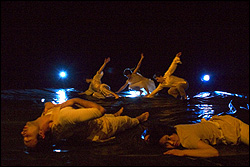In her newest work, Fade (at Consolidated Works through Saturday, April 2; 206- 325-6500), choreographer Crispin Spaeth may have come closer to her goal than she really wanted. Her description talks about an “exploration of the moment that vision falters, when light gives way to dark,” and for all the intriguing performance happening onstage, we get the feeling that the real dance might actually be going on somewhere else, beyond our peripheral vision.
From the opening tableau, with the dancers lying on a black plastic tarp that covers the floor and reflects the stage light into our eyes, we are unsure of what we’re seeing: how many people there are, where they’re going, what they might be doing, and why they are there. After the lights come up further and the tarp is pulled back to reveal a crisp white square of dancing space, there are plenty of other references to impaired vision. Fade includes a vicious game of blindman’s bluff, a set of swooning backward falls, and a long sequence where one of the performers seems to be dancing with her eyes closed. Even when we can see them, the dancers might not be able to see each other.
Spaeth has surrounded herself with some gifted collaborators. Etta Lilienthal designed a handsome stage space— that shimmering white square on the floor and a backdrop of heavy plastic sheeting that either reflects light or acts as a translucent window on the action happening behind. Rigmor Vohra and Kristina Olsen have made some very danceable costumes, and lighting designer Jon Harmon contributes some deceptively simple effects, the light levels hovering at that place where we begin to doubt our eyes. Yann Novak’s soundtrack underscores the action rather than leading it; the rustle of plastic at the opening echoes in his gentle static.
Despite all these elements, though, and the committed dancing of the cast—Heather Budd, Yuki Enomoto, Kathy Lawson, Chay Norton, and Julia Skloot—there is a curious indeterminacy to the piece. This could be a part of Spaeth’s plan, and it would be tempting to read more into the work than might actually be there, but the overall structure of the evening is unclear. It doesn’t reflect either the natural chaos of random ordering, where you surrender your own options to the roll of the dice, or the more obvious traditional composition, moving us briskly from introduction through development and conclusion. Fade hovers somewhere in between, and by staying in that middle place, Spaeth loses a number of choreographic tools that could highlight aspects of the work and give the audience a few more clues about this world and these people.
Even in works made with significant creative input from performers and collaborators, you can usually feel the hand of the choreographer in the final choices—what they’ve picked and the order they’ve put it in. That stamp wasn’t easy to see in this work. At just under an hour, the dance needs to make its points faster, or we’ll miss them. In past works, Spaeth has seemed to manage tasks like this easily, which makes the weakness in this piece even more curious. Although there are moments of clarity, intention, and energy in Fade, the whole feels like less than the sum of its parts. When a neon “Open” sign flashes on to signal the end of the work and artificial illumination takes the place of waning daylight, the audience blinks, wondering what it was they were actually watching.








